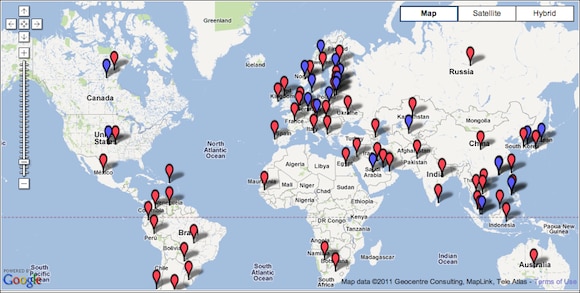 Fourth generation or 4G mobile networks promise faster connections enabling users to do more while on the go. There’s quite some confusion about what 4G actually is and what technologies can be called 4G or not. 3GPP Long Term Evolution, or LTE for short, seems to be the technology that currently shows the most promise to be able to cut the Ethernet umbilical cord and set us free. Other than the promise of speeds in excess of 100 Mbps, why should you be excited about LTE coming to where you live?
Fourth generation or 4G mobile networks promise faster connections enabling users to do more while on the go. There’s quite some confusion about what 4G actually is and what technologies can be called 4G or not. 3GPP Long Term Evolution, or LTE for short, seems to be the technology that currently shows the most promise to be able to cut the Ethernet umbilical cord and set us free. Other than the promise of speeds in excess of 100 Mbps, why should you be excited about LTE coming to where you live?
Fresh numbers [PDF] from Informa Telecoms & Media show a majority of the world’s population will have the the option of LTE for mobile broadband soon, with around ten percent already living where LTE is running. We crunched the numbers and here are the key facts:
- Around 13% of the world’s population live in countries where there are already running LTE implementations or where LTE is being deployed.
- Another 41% of the population live in countries where LTE is in trials, including countries like China and India.
- Finally, another 24% of the world’s population are awaiting LTE, with planned or launch to be decided status on LTE in their countries.
Note that this doesn’t take into account how widespread the actual implementations by operators are.
Out of all mobile subscriptions, LTE will for the foreseeable future account for only a small percentage of worldwide subscriptions. Less than 1%, in fact, and, according to Informa Telecoms & Media, LTE will account for just 8% still by 2016. If we put this in terms of actual subscribers instead, ABI Research predicts that there will be 16 million LTE subscribers by the end of 2011, which, if true, is a drastic rise from the 1.9 million subscribers in the second quarter of the year, stated by Informa Telecoms & Media, out of which 1.8 million are in the US and Canada.
Clearly the largest growth potential for LTE is outside traditional markets such as North America and Western Europe.

Picture courtesy of LTEMaps. In the picture, a red marker per country for all operators to show commitments and a blue marker to show actual deployments.
4G devices slowly emerging
The Global Mobile Suppliers Association (GSA) published an update to its Evolution of LTE report, confirming that 248 operators “have committed to commercial LTE network deployments or are engaged in trials, technology testing or studies.” GSA also stated that 197 LTE devices aimed at users have been announced, spanning 48 manufacturers.
So far we’ve not seen a huge amount of 4G-capable devices but major manufacturers such as Motorola and Samsung have already introduced both smartphones and tablets supporting 4G, and more is coming from them and others. In the “Worldwide LTE Mobile Phone 2011-2014 Forecast”, IDC analyst Ramon T. Llamas predicts that by end of this year, mobile phone vendors will ship a total of 5.5 million LTE mobile phones worldwide. That is still dwarfed by the worldwide shipments of an expected 420 million smartphones in 2011.
At Pingdom we’ve seen real life LTE demonstrations with download speeds of around 82 Mbps and upload speeds of around 67 Mbps. That’s not far from the stated LTE peak rates of 100 Mbps down and 50 Mbps up. To put that into perspective, Akamai’s most recent State of the Internet report for Q2 2011, shows an average connection speed from South Korea, the country usually rated as having the fastest Internet speed in the world, of almost 14 Mbps and 58% of connections to Akamai from there running at speeds over 5 Mbps.
Also, the Pingdom office is located in an area where a 4G network was launched over a year ago, promising speeds of up to 80 Mbps.
Real benefit or buzzword?
But is LTE just the emperor’s new clothes, dazzling us with faster speeds but offering little else?
There’s no denying that not being tied to the ethernet jack in the wall is a great attraction but what’s interesting will be what that speed offers us in terms of what we can do with it.
On a country level, something like LTE can mean the ability to develop telecommunications and skip ahead. Already back in 2008, China was reported as having surpassed the US as the number one country in the world in terms of Internet users. Earlier this year, Forbes reported that, according to China’s Telecommunications Administration Bureau, there are 477 million Internet users in the country. But as amazing as those numbers may be, China still lags in the backwaters of the Internet when it comes to connection speeds. Akamai’s figures show that the average connection speed in China climbed to just over 1 Mbps, with an average peak connection speed just over 4.6 Mbps. Also, the high broadband adoption speed (connections to Akamai faster than 5 Mbps) is lingering in low single digits (0.5%) and even broadband adoption (speeds of more than 2 Mbps) is very low at 9.3%.
On a user level, higher mobile broadband speeds offer the possibility of new applications like virtual and augmented reality, HD video streaming, and HD video conferencing. The development toward faster mobile broadband speeds go hand in hand with the development to faster processing power and more storage capacity in mobile devices. With dual-core processors and gigabytes of space, that part of the equation seems to be solved. Apps and other software that take advantage of the new speed and power is arguably the next frontier.
Next: will telcos manage?
With increased speed comes increased volumes of up- and downloads. Telcos around the world have already been complaining about smartphones and tablets sucking up too much bandwidth, and more recently about “chatty” apps that poll in the background, taking up even more of the scarce space in the wireless pipes. Will telcos manage with users filling up the space as LTE rolls out around the world? That’s a question for another blog post.


























